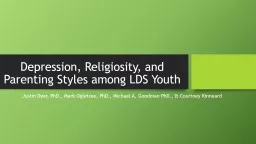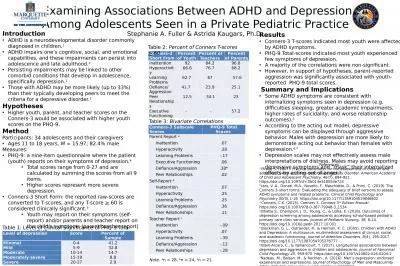PPT-Depression, Religiosity, and Parenting Styles among LDS Youth
Author : olivia-moreira | Published Date : 2018-10-24
Justin Dyer PhD Mark Ogletree PhD Michael A Goodman PhD amp Courtney Kinneard Depression Common Cold of Mental H ealth The mental disorder epidemic Rottenberg
Presentation Embed Code
Download Presentation
Download Presentation The PPT/PDF document "Depression, Religiosity, and Parenting S..." is the property of its rightful owner. Permission is granted to download and print the materials on this website for personal, non-commercial use only, and to display it on your personal computer provided you do not modify the materials and that you retain all copyright notices contained in the materials. By downloading content from our website, you accept the terms of this agreement.
Depression, Religiosity, and Parenting Styles among LDS Youth: Transcript
Justin Dyer PhD Mark Ogletree PhD Michael A Goodman PhD amp Courtney Kinneard Depression Common Cold of Mental H ealth The mental disorder epidemic Rottenberg 2014 Wakefield amp . Katie . Hanslits. and Stephanie Collins. Hanover College. Heavy Drinking Habits Among Parents. . Children of alcoholics have been shown to have less emotional support and monitoring. Heavy drinking by both parents is correlated with permissiveness in parenting (van . . Susan R. Harvey. Assistant Prosecuting Attorney. Oakland County . What is the role of the . Prosecutor’s Office in custody and parenting time?. The Law in Paternity Cases (DP). MCL 722.717b Order of Filiation, provisions for custody or parenting time. Volume 2:. Latter-Day . Saints. Latter-Day Saints . (a.k.a. Mormons). An American Revealed Scriptural Religion. A Sacred History for the Americas. An American Version of the Exodus Narrative. Latter-Day Saints (LDS). Mrs. Gudgeon. Child Development. SWBAT distinguish between parenting styles and discuss how they relate to human development.. Types of Parenting Styles and Outcomes. Most parents can be classified into three main types by the style in which they guide their children. As we discuss each, think about where your own parents fits most appropriately. Do each of your parents use the same style? Do you fit the outcome?. Unmasking the Church of Jesus Christ . of. . Latter-day . Saints . Dr. . Tal Davis . Email. : . josephtaldavis. @ . gmail.com. MarketFaith Ministries. www.marketfaith.org. LDS World Church Statistics. 1. . Jane Evans. Tuning In Beyond Trauma. © Jane Evans Parenting and Behaviour Skills Consultancy. 2. My Passion for Parenting……... In . our . homes and . hearts is . where the . greatest change can happen to . . A study of 1,612 LGBT/SSA Mormons and Former Mormons. John P. Dehlin, . Ph.D. , Bill Bradshaw, Ph.D., Renee . Galliher. , Ph.D.. Very Brief History of “Homosexuality” in the Church of Jesus Christ of Latter-day Saints (LDS Church). “Mormon”/LDS Client. A Multicultural Training. Presented by: . Kyle Oswald, LCSW-C. Counseling Manager. Md. , pa, dc, . wv. Population Uniqueness. A large part of what makes this population different, and therefore reluctant to seek therapy from a non-LDS provider comes from: . Let’s review…. Four Parenting Styles: What are they and their characteristics?. Authoritarian. Authoritative. Permissive. Uninvolved. Today’s Objectives…. Identify the pros and cons of spanking and how it can be used as a form of discipline.. Jim Rhodes. NW District 4-H Youth Development Program Specialist. September 2013. Learning Styles??. Term that refers to . different ways we learn, process and retain information. . . Children learn through:. Self-esteem. Maddie Nilson. Psy 1100-050. Parenting Styles. Authoritarian: Highly demanding and directive, yet unresponsive. Obedience and status oriented. Clearly stated rules, structured environments. . “Mormon”/LDS Client. A Multicultural Training. Presented by: . Kyle Oswald, LCSW-C. Counseling Manager. Md. , pa, dc, . wv. Population Uniqueness. A large part of what makes this population different, and therefore reluctant to seek therapy from a non-LDS provider comes from: . Toddlers 5.03. Parenting and Child Development . Parenting Styles. Authoritarian Parent . Excepts children to obey without question. Tells child what to do and . expects . it to be done immediately . Introduction. ADHD is a neurodevelopmental disorder commonly diagnosed in children.. 1. ADHD impairs one’s cognitive, social, and emotional capabilities, and these impairments can persist into adolescence and late adulthood..
Download Document
Here is the link to download the presentation.
"Depression, Religiosity, and Parenting Styles among LDS Youth"The content belongs to its owner. You may download and print it for personal use, without modification, and keep all copyright notices. By downloading, you agree to these terms.
Related Documents














